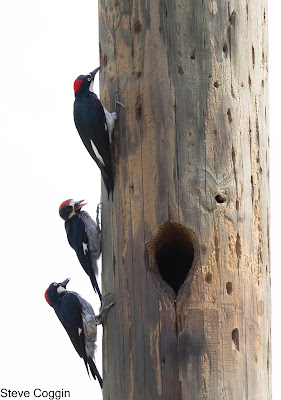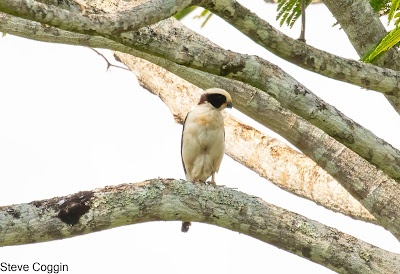 |
| Black Catbird (Melanptila glabrirostris). Caye Caulker, Belize |
After our sojourn to the Rio Bravo Conservation Area in northwestern Belize, the Mecklenburg Audubon birders went to the Crooked Tree Wildlife Sanctuary. This sanctuary is managed by Belize Audubon and is an area of rivers, lagoons, forests and savannas. It is situated in the north-central part of Belize. Our lodgings were at the Bird’s Eye View Lodge on the shores of the Crooked Tree Lagoon, a large freshwater lake and marsh.
 |
| Green Heron (Butorides virescens). New River, Belize. |
We took two boat trips on the New River during our time at Crooked Tree. The small motorboats we used allowed us intimate views of many birds that make their living along the river. Herons were abundant with the familiar Green Heron (Butorides virescens) stalking the water’s edge and the large and impressive Bare-throated Tiger-Herons (Tigrisoma mexicanum) hunting fish. The odd Boat-billed Herons (Cochlearius cochlearius), with their massive beaks, perched in trees along the river waiting for sunset to commence feeding.
 |
| Bare-throated Tiger-Heron (Tigrisoma mexicanum). New River, Belize. |
 |
| Boat-billed Heron (Cochlearius cochlearius). New River, Belize. |
Kingfishers were plentiful along the New River including the beautiful Green Kingfisher (Chloroceryle americana) with its green back and head, white collar and in the males, a red breast. We saw Russet-naped Wood-Rail (Aramides albiventris) hunting along the bank. This large rail is found only in Central America and Mexico. It has a yellow beak, red eyes, a gray head and back, rufous wings and, of course, a russet nape. Raptors were common along the river including the Snail Kite (Rostrhamus sociabilis). This predator has a hooked beak that it uses to extract snails from their shells.
 |
| Green Kingfisher (Chloroceryle americana). New River, Belize. |
 |
| Russet-naped Wood-Rail (Aramides albiventris). New River, Belize. |
 |
| Snail Kite (Rostrhamus sociabilis). New River, Belize. |
 |
| Jabiru (Jabiru mycteria). Crooked Tree Lagoon, Belize. |
 |
| Roseate Spoonbills (Platalea ajaja). Crooked Tree Lagoon, Belize. |
 |
| Mangrove Swallow (Tachycineta albilinea). Crooked Tree Lagoon, Belize. |
 |
| Gray-breasted Martin (Pogne chalybea). Crooked Tree Lagoon, Belize. |
 |
| Least Grebe (Tachybaptus dominicus). Crooked Tree Lagoon. |
 |
| Cinnamon-bellied Saltator (Saltator grandis). Crooked Tree Wildlife Sanctuary, Belize. |
 |
| Olive-throated Parakeets (Eupsittula nana). Crooked Tree Wildlife Sanctuary, Belize. |
Vermillion Flycatchers (Pyrocephalus obscurus) were nesting in the area. The males, with their black backs and eye-popping red heads and breasts contrasted with more delicately colored females. We also found a brilliant orange, black and white Altamira Oriole (Icterus gularis) on its impressive hanging nest.
 |
| Male Vermillion Flycatcher (Pyrocephalus obscurus). Crooked Tree Wildlife Sanctuary, Belize. |
 |
| Female Vermillion Flycatcher at its nest. Crooked Tree Wildlife Sanctuary, Belize. |
 |
| Altamira Oriole (Icterus gularis) at nest. Crooked Tree Wildlife Sanctuary, Belize. |
 |
| Ferruginous Pygmy Owl (Glaucidium brasilianum). Crooked Tree Wildlife Sanctuary, Belize. |
 |
| Ferruginous Pygmy Owl showing eyespots on the back of the head. Crooked Tree Wildlife Sanctuary, Belize. |
 |
| Acorn Woodpecker (Melanerpes formicivorus) at nest. An acorn is stored in a hole above the woodpecker. Crooked Tree Wildlife Sanctuary, Belize. |
 |
| An Acorn Woodpecker family and nest. Crooked Tree Wildlife Sanctuary, Belize. |
 |
| Yucatan Jay (Cyanocorax yucatanicus). Crooked Tree Wildlife Sanctuary, Belize. |
The forests of Crooked Tree had birds that are found throughout the tropics like Black-headed Trogons (Trogon melanocephalus) and White-fronted Parrots (Amazona albifrons).
 |
| Black-headed Trogon (Trogon melanocephalus). Lamanai Archeological Reserve, Belize. |
 |
| White-fronted Parrot (Amazona albifrons). Crooked Tree Wildlife Sanctuary, Belize. |
There were also birds that are endemic to the area like the delicate Rufous-breasted Spinetail (Synallaxis erythrothorax) and Yucatan Flycatcher (Myiarchus yucatanensis).
 |
| Rufous-breasted Spinetail (Synallaxis erythrothorax). Crooked Tree Wildlife Sanctuary, Belize. |
 |
| Yucatan Flycatcher (Myiarchus yucatanensis). Crooked Tree Wildlife Sanctuary, Belize. |
While most of our group left for home and others went to visit Mayan ruins, Diane and I went with our guide Roni to Caye Caulker, an island off the coast of Belize. We were in search of birds found only along the coast and others that are endemic to the area.
 |
| Cinnamon Hummingbird (Amazilia rutila). Caye Caulker, Belize. |
Cinnamon Hummingbirds (Amazilia rutila) are common on the island. They have a pink bill, green head and back and cinnamon-colored and tail. Common Black Hawks (Buteogallus anthracinus) feed mainly on crabs they catch in the mangroves. One of these large hawks was being harassed by a pair of Tropical Kingbirds (Tyrannus melancholicus) trying to chase the predator from their territory. White-crowned Pigeons (Patagioenas leucocephala) are found from South Florida, through the West Indies and along the Caribbean coast of Central America. These large pigeons are dark gray with a brilliant white cap on their heads were perched high in Casuarina trees (Casuarina equisetifolia).
 |
| Common Black Hawk (Buteogallus anthracinus) and Tropical Kingbirds (Tyrannus melancholicus). Caye Caulker, Belize. |
 |
| White-crowned Pigeon (Patagioenas leucocephala). Caye Caulker, Belize. |






























